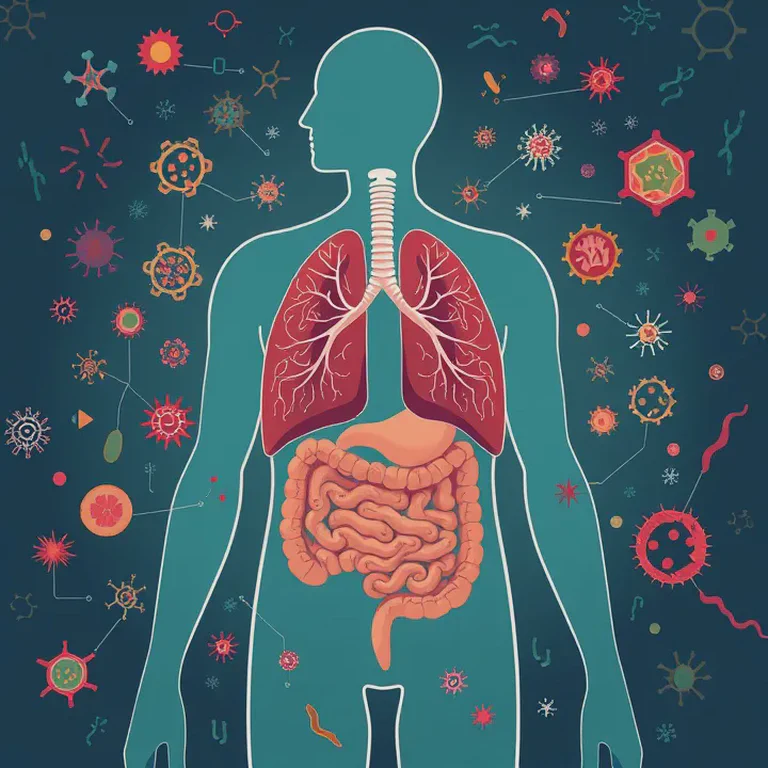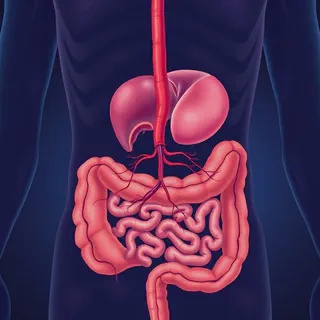This episode is part of our ongoing section: "II. The Gut-Organ Connection". In case you missed it, here's what we're covering in this exciting part of our series:
- The Gut-Heart Connection: Digestive Health and Cardiovascular Wellness
- The Gut-Lung Axis: How Digestive Health Influences Respiratory Wellness (That's this episode!)
- Gut Health and Liver Function: The Gut-Liver Axis Explained
- The Gut-Kidney Connection: How Digestive Health Affects Renal Function
- The Role of Gut Health in Cancer Prevention and Treatment
- Gut Health and Bone Density: Exploring the Connection
- Gut Health and Hair Growth: Unraveling the Connection
- Gut Health and Eye Health: A Clear Connection
- Gut Health and Oral Health: The Mouth-Gut Connection
- Gut Health and Thyroid Function: Understanding the Connection
- Gut Health and Adrenal Function: Balancing the Connection
- Gut Health and Reproductive Health: Fertility and Beyond
In our last episode, we explored the intricate connection between our gut and heart. Now, we're ready to ascend to new heights and examine how our gut health influences our respiratory system. So, take a deep breath, and let's dive into "The Gut-Lung Axis: How Digestive Health Influences Respiratory Wellness"!
Introduction: The Gut-Lung Axis 🫁
When we think about respiratory health, we often focus on the air we breathe and the condition of our lungs. But what if I told you that the key to better breathing might actually lie in your gut?
The gut-lung axis is an emerging field of study that explores the bidirectional communication between our digestive system and respiratory system. This fascinating connection reveals how the health of our gut can significantly impact our lung function and overall respiratory wellness.
A Brief History: From Separate Systems to Connected Organs
The idea that our gut health could influence our lungs isn't a new concept. Let's take a quick journey through time:
Historical Perspective: The Evolution of the Gut-Lung Axis
Ancient Concepts (Hippocrates and Early Medicine): Hippocrates, the "father of medicine," claimed that “all disease begins in the gut.” His holistic approach set the stage for understanding the interconnectedness of body systems.
17th-18th Century (Early Modern Medicine): Early anatomists began mapping bodily organs, with the invention of the microscope enabling the observation of bacteria. This period laid the groundwork for understanding microbial influences on health.
Germ Theory and the Microbial Revolution (19th Century): Louis Pasteur and Robert Koch’s discoveries in germ theory reshaped medicine. They proved that microorganisms caused disease, indirectly leading to research on microbial influences between different organ systems.
Immunology Developments (Early 20th Century): As immunology advanced, the gut’s role in systemic immunity became recognized, with early evidence suggesting its influence beyond digestion, including respiratory health.
The Microbiome Era (Mid-20th Century): Dr. Thomas Luckey’s research into the human microbiome, which he named in the 1950s, introduced the concept of microbes living symbiotically in the body, shifting attention to their systemic effects, including on the lungs.
The Gut-Lung Axis is Named (Late 20th Century): By the late 20th century, research began connecting gut dysbiosis with respiratory diseases like asthma and COPD. Pioneers like Dr. B. Brett Finlay demonstrated that gut health could influence lung inflammation, formalizing the concept of the gut-lung axis.
21st Century Breakthroughs (The Role of Microbial Interactions): Studies revealed that signals from gut bacteria regulate lung inflammation, and gut-derived microbial products can travel to the lungs. This established the gut-lung axis as a key area of focus for systemic health.
Pandemics and Global Health (COVID-19 and Beyond): The COVID-19 pandemic renewed interest in gut-lung interactions, showing that individuals with gut dysbiosis were more prone to severe respiratory infections. This pushed forward research into gut-targeted therapies to improve lung health.
The Gut-Lung Connection: How Does It Work?
So, how exactly does our gut influence our lung health? Let's break it down:
Immune System Regulation: The gut hosts a significant portion of the immune system. The gut microbiome influences lung immunity through cytokine signaling and T-cell differentiation, especially in promoting anti-inflammatory Tregs. Gut-associated lymphoid tissue (GALT) develops immune cells that migrate to the lungs. Dysbiosis can disrupt this balance, increasing lung inflammation and the risk of respiratory diseases.
Inflammation: Gut dysbiosis (imbalance in gut bacteria) can lead to systemic inflammation, which can affect lung health.
Microbial Migration: Some researchers suggest that microbes can actually travel from the gut to the lungs, influencing the lung microbiome.
Short-Chain Fatty Acids (SCFAs): These beneficial compounds produced by gut bacteria can have anti-inflammatory effects in the lungs.
Gut Permeability: A "leaky gut" can allow harmful substances to enter the bloodstream, potentially affecting lung health.
Key Players in the Gut-Lung Axis ♂️♀️
Let's meet some of the starring characters in this gut-lung drama:
Gut Microbiome: The trillions of microorganisms in our gut play a crucial role in this connection.
Immune Cells: Immune cells educated in the gut can travel to the lungs, influencing respiratory immune responses.
Epithelial Cells: These cells line both the gut and the lungs, forming crucial barriers.
Vagus Nerve: This major nerve connects the gut and lungs, allowing for rapid communication.
Cytokines: These signaling molecules can be produced in the gut and affect lung function.
Here’s the updated markdown code for the section, including the detail about Bifidobacteria:
How Gut Health Affects Specific Respiratory Conditions 🫧
Let's explore how gut health can influence various respiratory conditions:
Asthma: Studies have shown links between gut microbiome composition and asthma risk, especially in children.
Chronic Obstructive Pulmonary Disease (COPD): Gut dysbiosis has been observed in COPD patients and may contribute to disease progression.
Allergies: The gut microbiome plays a role in the development of allergies, including respiratory allergies.
Respiratory Infections: A healthy gut microbiome can enhance immune defenses against respiratory pathogens.
Cystic Fibrosis: Gut microbiome alterations have been observed in cystic fibrosis patients and may influence disease outcomes.
COVID-19: Emerging research suggests that gut health may affect immune responses to COVID-19. Notably, studies have found that individuals with severe COVID-19 symptoms often have a depletion of beneficial microbes like Bifidobacterium and Faecalibacterium, as well as decreased microbiome diversity. These changes correlate with SARS-CoV-2 positivity and severity. A balanced gut microbiome could potentially help mitigate the severity of symptoms and reduce the risk of complications.
Nurturing Your Gut for Healthy Lungs
Now that we understand the connection, how can we support both our gut and lung health? Here are some strategies:
Eat a Diverse, Fiber-Rich Diet: This supports a healthy gut microbiome and provides anti-inflammatory benefits.
Include Fermented Foods: Foods like yogurt, kefir, and sauerkraut can provide beneficial probiotics.
Consider Prebiotic Foods: Garlic, onions, and leeks feed beneficial gut bacteria.
Limit Processed Foods and Added Sugars: These can negatively impact both gut and lung health.
Stay Hydrated: Proper hydration supports both gut and lung function.
Manage Stress: Chronic stress can negatively impact both gut and lung health.
Exercise Regularly: Physical activity benefits both your gut microbiome and your lung function.
Practice Deep Breathing: This can help strengthen the gut-lung connection.
Avoid Unnecessary Antibiotics: While sometimes necessary, antibiotics can disrupt the gut microbiome.
Consider Probiotic Supplements: Some strains may support both gut and lung health, but consult with a healthcare provider first.
The Future of Gut-Lung Research
The field of gut-lung axis research is rapidly evolving. Some exciting areas of study include:
- Microbiome-Based Therapies: Developing treatments that target the gut microbiome to improve lung health.
- Personalized Nutrition: Tailoring diets based on individual gut microbiomes to optimize respiratory health.
- Gut-Lung Axis in Different Populations: Exploring how this connection may vary across different ages, ethnicities, and health conditions.
- Probiotic and Prebiotic Interventions: Investigating specific strains and fibers for lung health benefits.
- Gut-Derived Biomarkers: Using gut-based markers to predict respiratory disease risk or progression.
Conclusion: A Breath of Fresh Air for Gut Health
As we've explored throughout this episode, the connection between our gut and our lungs is both fascinating and far-reaching. By nurturing our gut health, we're not just supporting our digestive wellness – we're also taking care of our respiratory system.
Remember:
- A healthy gut microbiome can support lung health and immune function.
- Inflammation in the gut can impact respiratory wellness.
- Lifestyle factors that benefit the gut often benefit the lungs too.
- The gut-lung connection is a two-way street – what's good for one is often good for the other.
As we conclude this episode on the gut-lung axis, we hope you've gained a new appreciation for the incredible interplay between your digestive system and your respiratory health. From the bustling bacterial cities in your gut to the intricate airways of your lungs, your body is a marvel of biological cooperation.
Stay tuned for our next episode, where we'll explore another fascinating gut-organ connection. Until then, keep nurturing your gut, breathing deeply, and staying curious about the incredible connections within your body! 🫁
Books
For those eager to dive deeper into the gut-lung connection, here are some excellent reads:
"The Gut-Immune Connection: How Understanding the Connection Between Food and Immunity Can Help Us Regain Our Health" by Emeran Mayer This book explores the gut's role in immune function, which is crucial for lung health.
"Breath: The New Science of a Lost Art" by James Nestor While not specifically about the gut-lung axis, this book provides fascinating insights into breathing and lung health.
"The Good Gut: Taking Control of Your Weight, Your Mood, and Your Long-term Health" by Justin Sonnenburg and Erica Sonnenburg This book offers valuable insights into gut health that are relevant to overall wellness, including respiratory health.
"The Microbiome Solution: A Radical New Way to Heal Your Body from the Inside Out" by Robynne Chutkan This book explores how nurturing your gut microbiome can improve various aspects of health, including respiratory wellness.
"An Elegant Defense: The Extraordinary New Science of the Immune System" by Matt Richtel This book provides a comprehensive look at the immune system, which is crucial in understanding the gut-lung connection.
Happy reading, gut-lung explorers! 🫁

